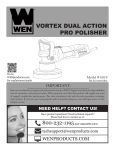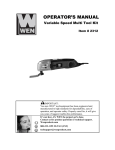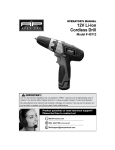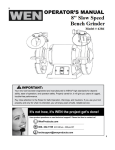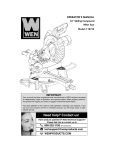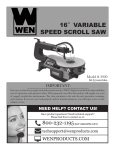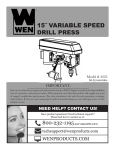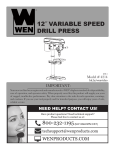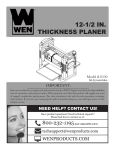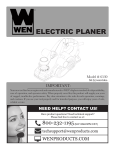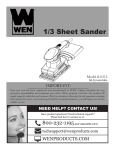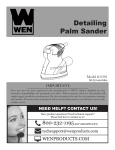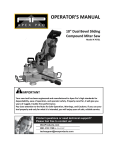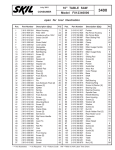Download WEN 70712 Use and Care Manual
Transcript
12˝ Single Bevel Sliding Compound Miter Saw Model # 70712 bit.ly/wenvideo IMPORTANT: Your new tool has been engineered and manufactured to WEN’s highest standards for dependability, ease of operation, and operator safety. When properly cared for, this product will supply you years of rugged, trouble-free performance. Pay close attention to the rules for safe operation, warnings, and cautions. If you use your tool properly and for intended purpose, you will enjoy years of safe, reliable service. NEED HELP? CONTACT US! Have product questions? Need technical support? Please feel free to contact us at: 800-232-1195 (M-F 8AM-5PM CST) [email protected] WENPRODUCTS.COM TABLE OF CONTENTS 2 3 4 5 7 8 12 15 16 19 Technical Data General Safety Rules Specific Safety Rules For Miter Saws Electrical Information Know Your Miter Saw Assembly and Adjustments Operation Maintenance Exploded View & Parts List Warranty TECHNICAL DATA Model Number: Motor: No Load Speed: Blade Size: Arbor Size: Number of Teeth: Miter Table Angles: Bevel Cuts: Weight: Cutting Capacity 0° Miter, 0° Bevel: 45° Miter, 0° Bevel: 0° Miter, 45° Bevel: 45° Miter, 45° Bevel: Includes: 2 70712 120 V, 60 Hz, 15A 5000 RPM 10˝ 1˝ 40 0° to 45° Left & Right 0° to 45° Left only 39 lbs 3-1/2˝ x 11-3/4˝ 3-1/2˝ x 7-7/8˝ 1-3/4˝ x 11-3/4˝ 1-3/4˝ x 7-7/8˝ Carbide-Tipped Blade (Installed) Hold Down Clamp Two Material Support Arms Dust Collection Bag Instruction Manual GENERAL SAFETY RULES Safety is a combination of common sense, staying alert and knowing how your item works. SAVE THESE SAFETY INSTRUCTIONS. WARNING: To avoid mistakes and serious injury, do not plug in your tool until the following steps have been read and understood. 1. READ and become familiar with this entire instruction manual. LEARN the tool’s applications, limitations, and possible hazards. 2. AVOID DANGEROUS CONDITIONS. Do not use power tools in wet or damp areas or expose them to rain. Keep work areas well lit. 3. DO NOT use power tools in the presence of flammable liquids or gases. 4. ALWAYS keep your work area clean, uncluttered, and well lit. DO NOT work on floor surfaces that are slippery with sawdust or wax. 5. KEEP BYSTANDERS AT A SAFE DISTANCE from the work area, especially when the tool is operating. NEVER allow children or pets near the tool. 6. DO NOT FORCE THE TOOL to do a job for which it was not designed. 7. DRESS FOR SAFETY. Do not wear loose clothing, gloves, neckties, or jewelry (rings, watches, etc.) when operating the tool. Inappropriate clothing and items can get caught in moving parts and draw you in. ALWAYS wear non-slip footwear and tie back long hair. 8. WEAR A FACE MASK OR DUST MASK to fight the dust produced by sawing operations. WARNING: Dust generated from certain materials can be hazardous to your health. Always operate the tool in a well-ventilated area and provide for proper dust removal. Use dust collection systems whenever possible. 9. ALWAYS remove the power cord plug from the electrical outlet when making adjustments, changing parts, cleaning, or working on the tool. 10. KEEP GUARDS IN PLACE AND IN WORKING ORDER. 11. AVOID ACCIDENTAL START-UPS. Make sure the power switch is in the OFF position before plugging in the power cord. 12. REMOVE ADJUSTMENT TOOLS. Always make sure all adjustment tools are removed from the saw before turning it on. 13. NEVER LEAVE A RUNNING TOOL UNATTENDED. Turn the power switch to OFF. Do not leave the tool until it has come to a complete stop. 3 GENERAL SAFETY RULES 14. NEVER STAND ON A TOOL. Serious injury could result if the tool tips or is accidentally hit. DO NOT store anything above or near the tool. 15. DO NOT OVERREACH. Keep proper footing and balance at all times. Wear oil-resistant rubber-soled footwear. Keep the floor clear of oil, scrap, and other debris. 16. MAINTAIN TOOLS PROPERLY. ALWAYS keep tools clean and in good working order. Follow instructions for lubricating and changing accessories. 17. CHECK FOR DAMAGED PARTS. Check for alignment of moving parts, jamming, breakage, improper mounting, or any other conditions that may affect the tool’s operation. Any part that is damaged should be properly repaired or replaced before use. 18. MAKE THE WORKSHOP CHILDPROOF. Use padlocks and master switches and ALWAYS remove safety keys. 19. DO NOT operate the tool if you are under the influence of drugs, alcohol, or medication that may affect your ability to properly use the tool. 20. USE SAFETY GOGGLES AT ALL TIMES that comply with ANSI Z87.1. Normal safety glasses only have impact resistant lenses and are not designed for safety. Wear a face or dust mask when working in a dusty environment. Use ear protection such as plugs or muffs during extended periods of operation. SPECIFIC RULES FOR MITER SAWS 1. Ensure that the lighting is adequate. 2. Do not use the saw unless the guards are in place. 3. Do not use the saw to cut metal or masonry. 4. Keep the area free of tripping hazards. 5. Do not let anyone under 18 years operate this saw. 6. Always stand to one side when operating saw. 7. Never use damaged or deformed saw blades. Only use sharp blades. 8. When cutting round wood, use clamps that prevent the workpiece from turning on both sides of the blade. 9. Never use your to remove sawdust, chips or waste from near the saw blade. 10. Only use blades as recommended by the manufacturer. 11. Do not use blades manufactured from high-speed steel. 12. If the table insert is damaged or worn, have it replaced by an authorized service center. 4 SPECIFIC RULES FOR MITER SAWS 13. Before making compound miter cuts, ensure that the work head is securely fixed in the desired position. 14. Rags, cloths, cord, string and the like should never be left around the work area. 15. Avoid cutting nails. Inspect workpieces and remove all nails and other foreign objects before beginning to saw. 16. Support the work properly. 17. Never reach over the blade to remove waste or cut-offs. 18. Do not attempt to free a jammed blade while the machine is still running. 19. Do not slow or stop a blade with a piece of wood. Let the blade come to rest naturally. 20. If you’re interrupted during operation, complete the task at hand and turn the saw off before looking up. 21. Periodically check that all nuts, bolts and other fastenersare properly tightened. 22. Always hold the saw by the insulated parts. If you accidentally cut into hidden wiring or the saw’s own cable, the metal parts of the saw will become electrified. Turn off and unplug immediately. 23.Connect the saw to a dust collection device that is operating properly. 24. Wear gloves when handling saw blades. 25. Keep the floor area around the machine level, well maintained and free of loose materials such as wood chips and cut-offs. 26. During slide cutting, always push the saw blade away as opposed to pulling it back towards you. 27. Always use stands to provide support for pieces that extend past the worktable. ELECTRICAL INFORMATION DOUBLE INSULATION Double insulation is a concept in safety in electric power tools, which eliminates the need for the usual three-wire grounded power cord. All exposed metal parts are isolated from the internal metal motor components with protecting insulation. Double insulated tools do not need to be grounded. WARNING: The double insulated system is intended to protect the user from shock resulting from a break in the tool’s internal insulation. Observe all normal safety precautions to avoid electrical shock. NOTE: Servicing of a product with double insulation requires extreme care and knowledge of the system and should be performed only by a qualified service technician. For service, we suggest you return the product to your nearest authorized service center for repair. Always use original factory replacement parts when servicing. WARNING: This tool is for indoor use only. Do not expose to rain or use in damp locations. 5 ELECTRICAL INFORMATION GUIDELINES FOR USING EXTENSION CORDS Make sure your extension cord is in good condition. When using an extension cord, be sure to use one heavy enough to carry the current your product will draw. An undersized cord will cause a drop in line voltage resulting in loss of power and overheating. The table below shows the correct size to be used according to cord length and nameplate ampere rating. When in doubt, use a heavier cord. The smaller the gauge number, the heavier the cord. Make sure your extension cord is properly wired and in good condition. Always replace a damaged extension cord or have it repaired by a qualified person before using it. Protect your extension cords from sharp objects, excessive heat and damp/wet areas. Use a separate electrical circuit for your tools. This circuit must not be less than a #12 wire and should be protected with a 15 A time-delayed fuse. Before connecting the motor to the power line, make sure the switch is in the OFF position and the electric current is rated the same as the current stamped on the motor nameplate. Running at a lower voltage will damage the motor. AMPERAGE 15 A REQUIRED GAUGE FOR EXTENSION CORDS 25 ft. 50 ft. 100 ft. 150 ft. 14 gauge 12 gauge Not Recommended WARNING: For your own safety, read the instruction manual before operating the miter saw. 1. Wear eye protection. 2. Do not wear gloves, a necktie, jewelry, or loose clothing. 3. Make sure the saw is on a firm, level surface and properly secured. 4. Use only the recommended accessories. 5. Use extra caution with very large, very small, or awkward workpieces. 6. Keep hands away from blade at all times to prevent accidental injury. 6 KNOW YOUR MITER SAW A M B L K C D J I E F G H A B C D E F G Operating Handle ON/OFF Switch Lower Blade Guard Fence Miter Table Table Insert Miter Table Lock H I J K L M Miter Scale Bevel Lock Knob Slide Bar Slide Lock Knob Dust Extraction Port Guard Retraction Arm UNPACKING If you find any pieces that are missing or wrong, do not operate the tool until the parts have been replaced. Failure to do so could result in serious personal injury. 1. Remove all loose parts from the carton. 2. Remove the packing materials from around the saw. 3. Using the carrying handle carefully lift the saw from the carton and place it on a level work surface. 4. The saw has been shipped with the saw arm locked in the down position. To release the saw arm, push down on the top of the saw arm, pull on the release knob (FIGURE 2), rotate it 45° and let go, slowly raise the saw arm. 5. Loose the slide lock knob (FIGURE 3). WARNING - Do not lift the saw while holding on to the guards. Use the carrying handle. 7 ASSEMBLY AND ADJUSTMENTS TRANSPORTATION Only lift the miter saw after switching off the saw, locking down the saw arm, and unplugging the machine from its power source. Only lift the saw by the carrying handle located on top of the motor or by the outer castings. Do not lift the saw using the guard or the operating handle. BENCH MOUNTING The saw base has holes in each corner to facilitate bench mounting (FIGURE 1). 1. Mount and fix the saw to a level, horizontal bench or worktable using four bolts (not included). 2. If desired, you can mount the saw to a piece of 1/2˝ or thicker plywood which can then be clamped to your work support or moved to other job sites and reclamped. CAUTION: Make sure that the mounting surface is not warped. Uneven surfaces can cause binding and inaccurate sawing. FIGURE 1 RELEASE KNOB The release knob is provided for holding the cutting head during transportation or storage. The saw must never be used while the release knob is locking the head down. SLIDE LOCK KNOB Release Knob When tightened, the slide lock knob (FIGURE 3) prevents the saw head from sliding. Tighten the slide lock knob during transportation. FIGURE 2 MITER TABLE LOCK The miter table lock is used to lock the table at the desired miter angle (FIGURE 4). The miter saw cuts from 0° to 45° both left and right. To adjust the angle, loosen the miter table lock,hold the miter release handle and rotate to the desired miter angle. Relock the table in place. The miter table features positive click stops at 0°, 15°, 22.5°, 31.6°, and 45° in both directions for quick setting of common miter angles. FIGURE 3 WARNING: Be sure to tighten the miter table lock before making a cut. Failure to do so can cause the table to move during the cut, resulting in serious personal injury. Miter Release Handle Miter Table Lock 8 FIGURE 4 ASSEMBLY AND ADJUSTMENTS BEVEL LOCK The bevel lock is used to set the blade at the desired bevel angle (FIGURE 5). The miter saw bevels from 0° to 45° left only. WARNING: Be sure to tighten the bevel lock before making a cut. Failure to do so could result in the saw arm moving during the cut and cause serious personal injury. HOLD DOWN CLAMP ASSEMBLY FIGURE 5 The hold down clamp assembly can be mounted to the fence on either side of the saw blade depending on what suits the task at hand. Use the clamp assembly lock at the back of the fence to secure teh clamp assembly in position (FIGURE 6). Note: use only one clamp at a time. SPINDLE LOCK BUTTON The spindle lock button prevents the blade in the saw from rotating (FIGURE 7). Depress and hold the spindle lock button while installing, changing or removing the blade. FIGURE 6 ROTATING LOWER BLADE GUARD The rotating lower blade guard provides protection from both sides of the blade (FIGURE 8). It retracts over the upper blade guard as the saw is lowered onto the workpiece. FIGURE 7 DUST COLLECTION BAG The dust collection bag fits over the dust extraction port. For more efficient operation, empty the dust bag when it is half full. This allows better air flow through the bag. ATTACHING THE MATERIAL SUPPORT ARMS FIGURE 8 The material support arms help to support the material when working with long workpieces. There are two location holes for support bars on either side of the table. Loosen the lock screws with the hex key. Ensure the side bars are fully inserted before using them to support the workpiece (FIGURE 9). The side support bar locking knob must be tightened to secure the support bars in position (FIGURE 9). FIGURE 9 Locking Knob 9 ASSEMBLY AND ADJUSTMENTS TURNING ON AND OFF 1. Pull the ON/OFF trigger switch found inside the front handle to start the miter saw. 2. To turn the saw off, release the ON/OFF trigger switch. SETTING THE TABLE SQUARE WITH THE BLADE 1. Make sure that the power cord is removed from the power source. 2. Push the saw arm down to its lowest position and engage the release knob (FIGURE 2). 3. Loosen the miter table lock (FIGURE 4). 4. Rotate the table until the pointer is positioned at 0°. 5. Tighten the miter table lock (FIGURE 4). 6. Loosen the bevel lock (FIGURE 11) and set the saw arm at 0° bevel (leaving the blade at 90° to the miter table). Tighten the bevel lock. 7. Place a set square against the table and the flat part of the blade (Figure 12). FIGURE 11 NOTE - Make sure that the square contacts the flat part of the saw blade, not the teeth. 8. Rotate the blade by hand and check the blade-to-table alignment at several points. 9. The edge of the set square and the saw blade should be parallel. 10. If the saw blade angles away from the set square, adjust as follows. 11. Use a 13mm wrench or adjustable wrench to loosen the lock nut securing the 0° bevel adjustment screw (FIGURE 13) to bring the saw blade into alignment with the square (FIGURE 19). 12. Adjust the 0° bevel adjustment screw (FIGURE 13) to bring the saw blade into alignment with the square (FIGURE 13). 13. Loosen the screw holding the pointer of the bevel scale and adjust the position of the pointer so that it accurately indicates zero on the scale (FIGURE 14). Retighten the screw. 14. Retighten the bevel lock (FIGURE 11) and the lock nut securing the 0° bevel adjustment screw (FIGURE 13). FIGURE 12 FIGURE 13 NOTE - The above procedure can also be used to check the angle of the saw blade to the table at the 45° bevel angle. FIGURE 14 10 ASSEMBLY AND ADJUSTMENTS SETTING THE FENCE SQUARE WITH THE TABLE 1. Make sure that the power cord is removed from the power source. 2. Push the saw arm down to it lowest position and engage the release knob (Figure 2) to hold the saw arm in the transport position. 3. Loosen the miter table lock (FIGURE 4). 4. Rotate the table until the pointer is positioned at 0°. 5. Tighten the miter lock (FIGURE 4). 6. Using the hex key, loosen the four screws securing the fence to the base (FIGURE 15). 7. Place a square against the fence and alongside the blade (FIGURE 16). 8. Adjust the fence until it is square with the blade. 9. Tighten the screws securing the fence. 10. Loosen the screw holding the pointer of the miter scale (FIGURE 17) and adjust it to so that it accurately indicates the zero position on the miter scale. 11. Retighten the screw securing the miter scale pointer. FIGURE 15 FIGURE 16 CHANGING A BLADE DANGER! Never try to use a blade larger than the stated capacity of the saw. It might come into contact with the blade guards. Never use a blade that is too thick to allow the outer blade washer to engage with the flats on the spindle. It will prevent the blade screw from properly securing the blade on the spindle. Do not use the saw to cut metal or masonry. Ensure that any spacers and spindle rings that may be required suit the fitted spindle and blade. 1. Make sure that the power cord is removed from the power source. 2. Push down on the operating handle and pull the release knob (FIGURE 2) to disengage the saw arm. The release knob can be turned so that it is held in the retracted position. 3. Raise the saw arm to its highest position. 4. Using a screwdriver loosen and remove the screw that secures the guard retraction arm to the rotating blade guard (FIGURE 18). 5. Using a hex key to loosen and remove the screw that secures the arbor bolt cover (FIGURE 19). 6. Pull the rotating blade guard down then swing it up together with the arbor bolt cover. When the rotating blade guard is positioned in the upwards position, it is possible to access the arbor bolt (FIGURE 20). 7. Hold the rotating guard up and press the spindle lock button (FIGURE 7). Rotate the blade until the spindle locks. 8. Use the hex key provided to loosen and remove the arbor bolt (loosen in a clockwise direction as the blade screw has a left-handed thread)(FIGURE 20). 9. Remove the outer flange washer and the blade. 10. Wipe a drop of oil onto the inner flange and the outer flange where they contact the blade. 11. Fit the new blade onto the spindle taking care that the inner flange sits behind the blade. FIGURE 17 FIGURE 18 FIGURE 19 FIGURE 20 11 CAUTION: To ensure the correct blade rotation, always install the blade with the blade teeth and the arrow printed on the side of the blade pointing downwards. The direction of the blade’s rotation is also stamped with an arrow on the upper blade guard. 12. Replace the outer flange. 13. Depress the spindle lock button (Figure 7) and replace the arbor bolt. 14. Use the hex key to tighten the arbor bolt securely (tighten in a counterclockwise direction). 15. After lowering the blade guard, hold the rotating lower blade guard and arbor bolt cover in position and tighten the fixing screw . 16. Replace the guard retraction arm and secure onto the rotating blade guard. 17. Check that the blade guard operates correctly and covers the blade as the saw arm is lowered. 18. Connect the saw to the power source and run the blade to make certain that it is operating correctly. OPERATION CROSS-CUTTING WITHOUT SLIDE ACTION When cutting a narrow piece of wood, it is not necessary to use the slide mechanism. In these cases, ensure that the slide lock knob is screwed down to prevent the saw arm from sliding. A cross cut is made by cutting across the grain of the work piece. A 90° crosscut is made with the miter table set at 0°. Miter cross cuts are made with the table set at some angle other than zero. 1. Pull on the release knob (FIGURE 2) and lift the saw arm to its full height. 2. Loosen the miter lock (FIGURE 4). 3. Rotate the miter table until the pointer aligns with the desired angle. 4. Retighten the miter lock by turning miter table lock (FIGURE 4). WARNING: Be sure to tighten the miter lock before making a cut. Failure to do so could result in the table moving during the cut and may cause serious personal injury. 5. Place the workpiece flat on the table with one edge securely against the fence. If the board is warped, place the convex side against the fence. If the concave side is placed against the fence, the board could break and jam the blade. 6. When cutting long pieces of timber, support the opposite end of the timber with either the side support arms, a roller stand, a work surface level with the saw’s table, or a combination of the three. 7. Use the clamp assembly to secure the workpiece wherever possible. 8. It is possible to remove the clamp assembly by loosening the clamp assembly lock and moving it to the other side of the table. Make sure the clamp assembly lock is tight before using the clamp (FIGURE 21). 9. Before turning on the saw, perform a dry run of the cutting operation to check FIGURE 21 that there are no problems. 10. Hold the operating handle firmly and squeeze the switch trigger. Allow the blade to reach maximum speed and slowly lower the blade into and through the workpiece. 11. Release the switch trigger and allow the saw blade to stop rotating before raising the blade out of the workpiece. Wait until the blade stops before removing the workpiece. 12 OPERATION CROSS-CUTTING WITH SLIDE ACTION When cutting wide work pieces, first unscrew the slide lock knob. 1. Pull on the release knob (FIGURE 2), raise the saw arm to its highest position and slide it towards you (FIGURE 22). 2. Hold the handle firmly and squeeze the switch trigger. Allow the blade to reach maximum speed. 3. Slowly lower the blade into the workpiece while pushing it away from you until the workpiece is cut. 4. Release the switch trigger and allow the saw blade to stop rotating before raising the blade out of the workpiece. Wait until the blade stops before removing the workpiece. BEVEL CUT A bevel cut is made by cutting across the grain of the workpiece with the blade angled to the fence and miter table. The miter table is set to the zero degree position with the blade angle between 0° and 45° (Fig. 23). Use the slide action when cutting wide workpieces. 1. Pull on the release knob (FIGURE 2) and lift the saw arm to its full height. 2. Loosen the miter lock (FIGURE 4). 3. Rotate the miter table until the pointer aligns with zero on the miter scale. 4. Retighten the miter lock (FIGURE 4). FIGURE 22 FIGURE 23 WARNING: Be sure to tighten the miter lock before making a cut. Failure to do so could result in the table moving during operation, causing serious personal injury. 5. Loosen the bevel lock (FIGURE 11) and pull out the 0° bevel adjuster. Move the saw arm to the desired bevel angle (between 0° and 45°). Tighten the bevel lock (FIGURE 11). 6. Place the workpiece flat on the table with one edge securely against the fence. If the board is warped, place the convex side against the fence. If the concave side is placed against the fence, the board could break and jam the blade. 7. When cutting long pieces of timber, support the opposite end of the timber with the sidebars, a roller stand or a work surface that is level with the saw table. 8. Use the clamp assembly to secure the workpiece wherever possible. 9. It is possible to remove the clamp assembly by loosening the clamp assembly lock and moving it to the other side of the table. Make sure the clamp assembly lock is tight before using the clamp. 10. Before turning on the saw, perform a dry run of the cutting operation to check that there are no problems. 11. Hold the operating handle firmly and squeeze the switch trigger. Allow the blade to reach maximum speed. 12. Slowly lower the blade into and through the workpiece. 13. Once the cut has been made, release the switch trigger and allow the saw blade to stop rotating before raising the blade out of the workpiece. Wait until the blade stops before removing the workpiece. 13 OPERATION COMPOUND MITER CUT A compound miter cut involves using a miter angle and a bevel angle at the same time (FIGURE 24). Always make a test cut on a piece of scrap wood before cutting into good material. Use the slide action when cutting wide workpieces. 1. Pull on the release knob (FIGURE 2) and lift the saw arm to its full height. 2. Loosen the miter lock (FIGURE 4). 3. Rotate the miter table until the pointer aligns with the desired angle on the miter scale. 4. Retighten the miter lock (FIGURE 4). FIGURE 24 WARNING: Be sure to tighten the miter lock before making a cut. Failure to do so could result in the table moving during the cut, causing serious personal injury. 5. Loosen the bevel lock (FIGURE 11) and pull out the 0º bevel adjuster and move the saw arm to the left or right to the desired bevel angle (between 0° and 45°). Tighten the bevel lock (FIGURE 11). 6. Place the workpiece flat on the table with one edge securely against the fence. If the board is warped, place the convex side against the fence. If the concave side is placed against the fence, the board could break and jam the blade. 7. When cutting long pieces of timber, support the opposite end of the timber with the sidebars, a roller stand or a work surface that is level with the saw table. 8. Use the clamp assembly to secure the workpiece wherever possible. 9. It is possible to remove the clamp assembly by loosening the clamp assembly lock and moving it to the other side of the table. Make sure the clamp assembly lock is tight before using the clamp. 10. Before turning on the saw, perform a dry run of the cutting operation to check that there are no problems. 11. Hold the operating handle firmly and squeeze the switch trigger. Allow the blade to reach maximum speed and slowly lower the blade onto and through the workpiece. 12. Release the switch trigger and allow the saw blade to stop rotating before raising the blade out of the workpiece. Wait until the blade stops before removing the workpiece. Note: Wear eye protection when brushing dust away. 14 MAINTENANCE WARNING: Always ensure that the tool is switched off and the plug is removed from the outlet before making any adjustments or maintenance procedures. •Any damage to this tool should be repaired and carefully inspected by qualified repair personnel before use. •Have your power tool serviced by a qualified repair person using only identical replacement parts. This will maintain the safety of the power tool. •Great Lakes Technologies, LLC will not be responsible for any damage or injury caused by unauthorized repair or mishandling of the tool. POWER CORD MAINTENACE If the supply cord needs replacing, the manufacturer, the manufacturer’s agent, or an authorized service centre must carry out the task in order to avoid a safety hazard. CLEANING 1. Keep the tool’s air vents unclogged and clean at all times. 2. Remove dust and dirt regularly. Cleaning is best done with a soft brush or a rag. 3. Re-lubricate all moving parts at regular intervals. 4. Never use caustic agents to clean plastic parts. CAUTION: Do not use cleaning agents to clean the plastic parts of the saw. A mild detergent on a damp cloth is recommended. Regularly check that all screws are tight. They may vibrate loose over time. 15 EXPLODED VIEW & PARTS LIST 16 EXPLODED VIEW & PARTS LIST Item 1 2 3 4 5 6 7 8 9 10 11 12 13 14 15 16 17 18 19 20 21 22 23 24 25 26 27 28 29 30 31 32 33 34 35 36 37 38 39 40 41 42 43 44 45 46 47 48 49 50 51 52 Stock # 70712B-001 70712B-002 70712B-003 70712B-004 70712B-005 70712B-006 70712B-007 70712B-008 70712B-009 70712B-010 70712B-011 70712B-012 70712B-013 70712B-014 70712B-015 70712B-016 70712B-017 70712B-018 70712B-019 70712B-020 70712B-021 70712B-022 70712B-023 70712B-024 70712B-025 70712B-026 70712B-027 70712B-028 70712B-029 70712B-030 70712B-031 70712B-032 70712B-033 70712B-034 70712B-035 70712B-036 70712B-037 70712B-038 70712B-039 70712B-040 70712B-041 70712B-042 70712B-043 70712B-044 70712B-045 70712B-046 70712B-047 70712B-048 70712B-049 70712B-050 70712B-051 70712B-052 Description Bolt M8X30 Nut Slide lock knob Spring Washer Arm Flange Pole back stand Bolt Line button Bolt Bolt Washer Bevel lock knob Nut Washer Washer Pointer Washer Washer Bolt Pole Knob Wing bolt Clamp Clamp slice Block circle Bolt Washer Wing bolt Right slid Fence Fence left slid fence Support arm Base Bolt Knob Rubber foot locking bar Washer Spring Miter release handle Miter lock knob Bolt Table Nut bolt Spring card Pointer scale label bolt Qty 1 2 1 1 1 1 2 2 1 1 2 4 4 2 1 2 2 1 1 5 4 1 1 1 2 1 1 1 2 8 2 1 1 1 2 1 1 3 4 1 1 2 1 1 1 1 1 7 1 1 1 1 Item 53 54 55 56 57 58 59 60 61 62 63 64 65 66 67 68 69 70 71 72 73 74 75 76 77 78 79 80 81 82 83 84 85 86 87 88 89 90 91 92 93 94 95 96 97 98 99 100 101 102 103 104 Stock # 70712B-053 70712B-054 70712B-055 70712B-056 70712B-057 70712B-058 70712B-059 70712B-060 70712B-061 70712B-062 70712B-063 70712B-064 70712B-065 70712B-066 70712B-067 70712B-068 70712B-069 70712B-070 70712B-071 70712B-072 70712B-073 70712B-074 70712B-075 70712B-076 70712B-077 70712B-078 70712B-079 70712B-080 70712B-081 70712B-082 70712B-083 70712B-084 70712B-085 70712B-086 70712B-087 70712B-088 70712B-089 70712B-090 70712B-091 70712B-092 70712B-093 70712B-094 70712B-095 70712B-096 70712B-097 70712B-098 70712B-099 70712B-100 70712B-101 70712B-102 70712B-103 70712B-104 Description bolt Change block Washer Nut Table insert Release knob Spring Pin Pin Bearing Stand Bolt Spring Pin Plastic cover Guard retraction arm Bolt Needle bearing Block circle Gear Front cover bearing Bearing cover Washer Bolt Output shaft Half round key Inner flange Blade Outer flange Arbor bolt Blade cover Dust collection bag Gear cover Spindle lock button Spring Block circle Bearing Rotor Bearing Block circle Bolt Stator Motor house Brush hold cover Carbon brush Brush hold Washer Washer Bolt Bolt Carry handle Qty 1 1 1 1 1 1 1 1 1 3 1 1 1 1 1 1 2 1 1 1 1 1 1 2 2 1 1 1 1 1 1 1 1 1 1 1 1 1 1 1 1 2 1 1 2 2 2 4 4 4 2 1 17 EXPLODED VIEW & PARTS LIST Item 105 106 107 108 109 110 111 112 113 114 115 116 117 118 119 120 121 122 123 124 125 18 Stock # 70712B-105 70712B-106 70712B-107 70712B-108 70712B-109 70712B-110 70712B-111 70712B-112 70712B-113 70712B-114 70712B-115 70712B-116 70712B-117 70712B-118 70712B-119 70712B-120 70712B-121 70712B-122 70712B-123 70712B-124 70712B-125 Description Bolt Up handle switch button Spring Switch Down handle Press line plank Bolt Cable shell Power cord Bolt Nut Small cover slice Big cover slice Bolt Washer Bolt Coi spring Blade guard Plate Bolt Qty 4 1 1 1 1 1 1 3 1 1 2 1 1 1 1 1 1 1 1 1 1 LIMITED ONE YEAR WARRANTY WEN Products is committed to build tools that are dependable for years. Our warranties are consistent with this commitment and our dedication to quality. LIMITED WARRANTY OF WEN CONSUMER POWER TOOLS PRODUCTS FOR HOME USE GREAT LAKES TECHNOLOGIES, LLC (“Seller”) warrants to the original purchaser only, that all WEN consumer power tools will be free from defects in material or workmanship for a period of one (1) year from date of purchase. Ninety days for all WEN products, if the tool is used for professional use. SELLER’S SOLE OBLIGATION AND YOUR EXCLUSIVE REMEDY under this Limited Warranty and, to the extent permitted by law, any warranty or condition implied by law, shall be the repair or replacement of parts, without charge, which are defective in material or workmanship and which have not been misused, carelessly handled, or misrepaired by persons other than Seller or Authorized Service Center. To make a claim under this Limited Warranty, please contact us at 1-800-232-1195. To acquire service, you will have to provide proof of purchase and may be asked to ship the tool back to us freight prepaid. THIS LIMITED WARRANTY DOES NOT APPLY TO ACCESSORY ITEMS SUCH AS CIRCULAR SAW BLADES, DRILL BITS, ROUTER BITS, JIGSAW BLADES, SANDING BELTS, GRINDING WHEELS, MOTOR BRUSHES AND OTHER RELATED ITEMS. ANY IMPLIED WARRANTIES SHALL BE LIMITED IN DURATION TO ONE (1) YEAR FROM DATE OF PURCHASE. SOME STATES IN THE U.S., SOME CANADIAN PROVINCES DO NOT ALLOW LIMITATIONS ON HOW LONG AN IMPLIED WARRANTY LASTS, SO THE ABOVE LIMITATION MAY NOT APPLY TO YOU. IN NO EVENT SHALL SELLER BE LIABLE FOR ANY INCIDENTAL OR CONSEQUENTIAL DAMAGES (INCLUDING BUT NOT LIMITED TO LIABILITY FOR LOSS OF PROFITS) ARISING FROM THE SALE OR USE OF THIS PRODUCT. SOME STATES IN THE U.S. AND SOME CANADIAN PROVINCES DO NOT ALLOW THE EXCLUSION OR LIMITATION OF INCIDENTAL OR CONSEQUENTIAL DAMAGES, SO THE ABOVE LIMITATION OR EXCLUSION MAY NOT APPLY TO YOU. THIS LIMITED WARRANTY GIVES YOU SPECIFIC LEGAL RIGHTS, AND YOU MAY ALSO HAVE OTHER RIGHTS WHICH VARY FROM STATE TO STATE IN THE U.S., PROVINCE TO PROVINCE IN CANADA AND FROM COUNTRY TO COUNTRY. THIS LIMITED WARRANTY APPLIES ONLY TO PORTABLE ELECTRIC TOOLS, BENCH POWER TOOLS, OUTDOOR POWER EQUIPMENT AND PNUMATIC TOOLS SOLD WITHIN THE UNITED STATES OF AMERICA, CANADA AND THE COMMONWEALTH OF PUERTO RICO. FOR WARRANTY COVERAGE WITHIN OTHER COUNTRIES, CONTACT THE WEN CUSTOMER SUPPORT. 19 Thanks for remembering 20




















